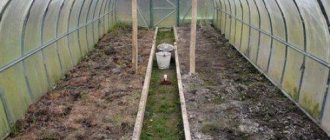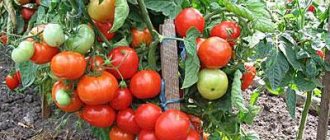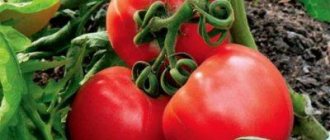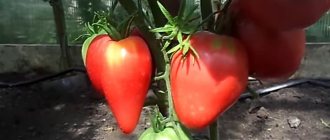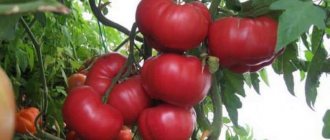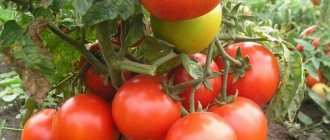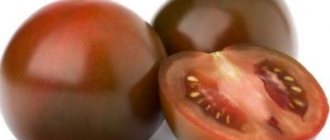Pests and diseases: prevention and treatment
The tomato variety Lorraine Beauty is quite resistant to viruses (mosaic, fusarium wilt).
However, bushes can be affected by gray, white or root rot. Preliminary watering of the soil with a solution of potassium permanganate or copper sulfate, constant loosening and mulching of the rows with peat or straw helps in the fight.
Tomatoes attract pests that spoil leaves and roots: aphids, whiteflies, thrips. In open ground, plants can be attacked by slugs, cutworms and Colorado potato beetles.
For prevention, you can plant herbs next to the tomatoes, for example, leaf mustard or parsley. Spraying with an aqueous solution of ammonia helps destroy pests. Insecticides should not be used after flowering has begun.
Lorraine Beauty tomatoes are a rare and unusual variety that is worth trying to grow on your own plot
It is not too demanding on living conditions; it is important to monitor watering and temperature, as well as protect plants from pests
One or two bushes in a greenhouse are enough to surprise your home with elegant chrysanthemum tomatoes for several months.
Secrets of successful cultivation
It is better to grow this variety using the seedling method - this will help achieve the highest possible productivity.
Deadlines
The optimal time for sowing seeds for seedlings is the first ten days of March. Two months before transplanting to a garden bed in a greenhouse or open ground, the seedlings will have time to grow the root system and foliage, and also reach the required height - 25-30 cm.
Seeds
It is advisable to germinate the seeds before sowing
You can plant a yellow or red variety using purchased material from a gardening store. You can also use seeds obtained from your own harvest.
Before sowing, you need to select high-quality seeds - dip them in a saline solution of 1 tsp. salt and 1 liter of water for half an hour. Seeds that have sunk to the bottom of the container are considered good.
Tatyana Orlova (Vasilidchenko) (candidate of agricultural sciences):
1 gram contains 200-250 tomato seeds. If the package with seeds indicates a weight of 0.1 g, then there are approximately 20-24 seeds in the package.
They are washed in clean water, then disinfected in a raspberry solution of potassium permanganate. After 30 minutes, remove, wash with water and spray with any growth stimulator - Epin, Zircon. This treatment is necessary to increase the percentage of seed germination after sowing.
For rapid germination, the seed is wrapped in damp gauze and placed in a warm place for a day. To avoid drying out, they need to be sprayed several times with a spray bottle.
Container and soil
You can sow in any container with a height of at least 10 cm and with drainage holes. Seedling boxes, plastic containers, disposable cups or peat pots are suitable. The last option is the most optimal - there is no need to pick the sprouts. In addition, peat pots decompose well in the soil, so tomatoes are planted in holes along with seedling containers.
Tatyana Orlova (Vasilidchenko) (candidate of agricultural sciences):
Peat cups will begin to fall apart within 60-65 days of growing tomato seedlings in them. They are usually used for growing seedlings of crops that do not tolerate transplantation, such as cucumbers, zucchini, and watermelons. The period for growing seedlings of these crops and using peat cups is about 1 month. The cups can be used for tomatoes after picking - plant the picked seedlings in them.
Tomatoes like to grow in light, loose soil with neutral acidity. There are two mixture options:
- purchased substrate for growing vegetable seedlings;
- homemade soil mixture of garden soil, sand and humus mixed in equal parts.
Before placing it in a planting container, the soil is disinfected in any convenient way - calcined in the oven, spilled with a strong solution of potassium permanganate or boiling water. The container is not filled with soil to the very top - leave 2-3 cm of empty space.
Sowing technique
In order for the seedlings to germinate faster, the seeds need to be planted to a depth of no more than 1 cm. Grooves are made in the seedling boxes at a distance of 5 cm from each other. Then the seeds are sown, keeping a distance of 3-4 cm. Sprinkle the top with a thin layer of earth and irrigate with a sprayer.
When planting in peat containers or disposable plastic containers, place 1-2 seeds per container.
After sowing, the seeds are watered with warm water, covered with transparent material, providing greenhouse conditions, and kept in room conditions with diffused daylight. You can place boxes with seedlings on the southeast or southwest windowsill.
Until the seedlings emerge, the seedlings are periodically ventilated to avoid mold, and also irrigated with water - every other day.
A week later, when sprouts appear, the shelter is removed and the seedlings are placed in a well-lit but cool place with a temperature of 15-17°C. Such conditions are necessary to avoid stretching of sprouts and stimulate the growth of the root system. After a week, the seedlings are returned to their original location.
When planting in groups, the sprouts need to be planted in separate containers at the stage of the appearance of the first true leaves. The soil is well watered, then the sprouts are removed and, together with the earthen lump, transferred into separate containers. All voids are filled with fertile soil (garden soil mixed with humus).
Description and characteristics of the tomato variety Lorraine beauty
If we classify tomatoes by application, we can distinguish four large groups - salad, processed, universal, decorative and gift - with specific and unusual fruits. One of the brightest representatives of the latter is the Lorraine beauty tomato. Their main purpose is to decorate the table.
Fruit characteristics
The Lorraine beauty tomato is an elegant large, ribbed, rounded fruit, flattened at the top. Outwardly they look like a closed flower with wide petals. The color of ripe tomatoes is bright scarlet. Weight is 200-350 grams, with proper agricultural technology it can reach half a kilogram.
The inside is multi-chambered, hollow, almost without seeds. The taste is sweetish with sourness. Suitable only for fresh consumption - slicing or stuffing looks impressive on the table. Dense, resistant to cracking. They are stored for a long time. They ripen well when picked brown.
Properties of the variety
The tomato is of American origin, more precisely of US selection. Tomatoes are of indeterminate type, with a height of 1.5 to 2 meters. The average late ripening period is 110-120 days. It is grown both in greenhouses and open ground. Self-pollinating. Productivity is low - no more than 3-4 kg per bush. Under unfavorable weather conditions, you can generally get 2-3 tomatoes.
The characteristics of resistance to viral and fungal diseases are as follows: resistant to Fusarium wilt, gray leaf spot, tobacco mosaic, Alternaria stem cancer, verticillium, cladosporiosis, nematode. Not resistant to root and white rot.
The bush is not standard - the stems are thin in constitution, large, slightly corrugated leaves. You can also add to the description of the variety that due to its specificity, it is not grown in agriculture on an industrial scale. This is a tomato for amateur gardeners and collectors of unusual plants.
Features of cultivation
Tomatoes of the Lorraine Beauty variety are no different in cultivation technology from most classic varieties:
- sowing seeds - obtaining seedlings.
- picking.
- transplanting.
- cultivation - watering, fertilizing, garter formation.
- harvesting.
Sowing seeds for seedlings for open ground, taking into account the climate zone, is carried out no earlier than two months before the onset of stable warm weather. After 3-4 weeks, in the phase of 2-3 true leaves, they peak. They are planted approximately 30 days after picking. If warm weather has not yet established itself, the seedlings should be “tempered” - treated with the drug “Tur” or another growth regulator to avoid overgrowth.
The planting pattern is 60 x 50. The interval along the rows is 60 cm, between plants 45-50. Due to its resistance to cracking, the beauty does not require strict adherence to the watering regime, but the soil should not be allowed to dry out too much.
The formation of the bush is carried out by removing the stepsons and gartering. It is produced in one trunk, however, according to reviews from gardeners, there is successful experience in growing tomatoes in two trunks.
Selection of fertilizers according to the classic P-NK scheme. During the development period, the complex contains a large percentage of nitrogen, during flowering and ovary - phosphorus, and when fruits ripen, potassium is needed. To prevent blossom end rot, periodically give Ca, that is, calcium nitrate. Fruiting continues as long as weather conditions permit. With the onset of cold weather, the still green fruits will grow well at room temperature.
Lorraine beauty yellow
In addition to red, there is also a yellow variety with ribbed, corrugated fruits. In terms of general characteristics, these two tomatoes are similar - both are indeterminate in the average ripening period. The color of the tomato is bright yellow-orange. The cutting looks very beautiful together with red ones, very similar to flowers.
Advantages and disadvantages of the variety
The advantages include the following:
- Lorraine beauty, a spectacular, unusual-looking tomato reminiscent of dahlia flowers;
- high taste qualities;
- resistant to most diseases;
- unpretentious, easy to grow;
- It is possible to form a bush into two trunks.
The disadvantage is the low yield, which is highly dependent on weather conditions. Due to the long ripening period, in the north, tomatoes are cultivated only in greenhouses.
Fruit characteristics
The Lorraine beauty tomato is an elegant large, ribbed, rounded fruit, flattened at the top. Outwardly they look like a closed flower with wide petals. The color of ripe tomatoes is bright scarlet. Weight is 200-350 grams, with proper agricultural technology it can reach half a kilogram.
The inside is multi-chambered, hollow, almost without seeds. The taste is sweetish with sourness. Suitable only for fresh consumption - slicing or stuffing looks impressive on the table. Dense, resistant to cracking. They are stored for a long time. They ripen well when picked brown.
Description of the variety Lorraine beauty
The Lorraine beauty tomato is an indeterminate variety; the bush grows up to two meters in height and requires mandatory cultivation, including pinching and staking. It is considered mid-early, but in the domestic climate, when grown in open ground, it is rather mid-late: the fruits are harvested no earlier than August. Although it was bred for unprotected soil, it grows and bears fruit normally in greenhouses. Loves warmth: it grows in cold climates, but the yield is greatly reduced. Disease resistance is average.
The Lorraine beauty tomato bushes are tall, but there are few fruits on them, and they are not aligned in size
Caring for this variety is simple and no different from caring for unpretentious tomatoes. The yield of the variety is average: the fruits are quite large, but their total number on the plant rarely exceeds one and a half dozen, and usually only 8–10 pieces. On average, tomatoes slightly fall short of 500 g, but sometimes there are kilogram specimens. Fruit ripening is uneven, spread over one and a half to two months.
Among the fruits there are also giants
The variety was first considered red-fruited, but a little later a yellow-fruited version was also developed. The fruits of both varieties are identical in shape and size, flat-round, strongly ribbed. The taste is sweetish; many lovers rate it as good, but too dry. The yellow (rather orange) Lorraine beauty contains slightly more sugars compared to the red one (more correctly, scarlet: the color can be blood red, and sometimes ruby).
The shape and purpose of yellow fruits are the same as red ones
The fruits on the bushes do not crack and can easily be transported. They are consumed only fresh. Sliced into layers, tomatoes of this variety are used to decorate salads, various appetizers and main courses. The ability to decorate dishes is due to the fact that the fruits are half-empty inside and contain chamber-pockets in which there are almost no seeds. Tomatoes of this variety are not used for harvesting.
Reviews from gardeners about the Lorraine beauty
Beauty Lottringa Orange - Lorraine Beauty Orange A very productive variety of ribbed tomatoes. An analogue of the Lorraine Beauty variety, only orange in color and more productive. Tropical fruit taste. Will decorate any table.
MKN
https://forums.drom.ru/vladivostok/t1152061601-p55.html
Lorraine beauty - red-raspberry, my record is 850 gr. there are no problems at all, I just pinch the stepsons, there are 3-4 pieces in the brush, the branch-brush itself is so thick and short, it seems that the tomatoes are growing right on the stem, the brush does not break. However, this year some tomatoes had “voids” “inside, probably from the crazy heat (although I’ve been planting this variety for a long time and this has never happened before) Very powerful bushes, unusual shape and large size evoke admiration and surprise among guests and neighbors...
Natalia
https://forum.vinograd.info/showthread.php?p=203823
Features of cultivation
Tomatoes of the Lorraine Beauty variety are no different in cultivation technology from most classic varieties:
- sowing seeds - obtaining seedlings.
- picking.
- transplanting.
- cultivation - watering, fertilizing, garter formation.
- harvesting.
Description of the tomato variety Black Pearl, cultivation features and careRead
Sowing seeds for seedlings for open ground, taking into account the climate zone, is carried out no earlier than two months before the onset of stable warm weather. After 3-4 weeks, in the phase of 2-3 true leaves, they peak. They are planted approximately 30 days after picking. If warm weather has not yet established itself, the seedlings should be “tempered” - treated with the drug “Tur” or another growth regulator to avoid overgrowth.
The planting pattern is 60 x 50. The interval along the rows is 60 cm, between plants 45-50. Due to its resistance to cracking, the beauty does not require strict adherence to the watering regime, but the soil should not be allowed to dry out too much.
Selection of fertilizers according to the classic P-NK scheme. During the development period, the complex contains a large percentage of nitrogen, during flowering and ovary - phosphorus, and when fruits ripen, potassium is needed. To prevent blossom end rot, periodically give Ca, that is, calcium nitrate. Fruiting continues as long as weather conditions permit. With the onset of cold weather, the still green fruits will grow well at room temperature.
Additional care
- Tomatoes of the Lorraine beauty variety love warmth. In bad weather conditions it can produce below average yields. This becomes another reason for growing in greenhouses, where the temperature can be artificially increased.
- Growing seedlings is standard. Picking of seedlings is carried out after the appearance of 2-3 true leaves. Nutrient mixtures should be used and fertilizing should be carried out so that the root system has time to strengthen before planting in the ground.
- Tomato fruits are large and heavy, so you should additionally tie up not only the plant itself, but also strengthen the brushes. When growing outdoors, you should choose places where the wind force is minimal. Otherwise, strong winds may break the plant.
Advantages and disadvantages compared to other similar varieties
The Lorraine beauty tomato is grown infrequently, but is well described in the literature, and there are reviews about it from amateur gardeners. At the same time, both the advantages of the variety and its disadvantages are noted. The advantages include:
- original unusual appearance of tomatoes;
- long-term preservation and transportability of fruits;
- the ability of tomatoes to ripen during storage;
- good, for an ornamental variety, sweetish taste;
- resistance to a number of diseases.
The list of disadvantages includes:
- hollowness of fruits;
- presence of dryness in taste;
- unsuitability of fruits for processing;
- significant dependence of yield on weather.
So, in the central zone of our country, the Lorraine beauty can still be grown in unprotected soil, but a little further north it can bear fruit normally only in greenhouses.
There are very few varieties intended specifically for decoration, but there are tomatoes with a similar, strongly ribbed fruit shape. Thus, the new domestic variety Garmoshka is considered a salad variety and is characterized by excellent taste and high yield. The fruits are pink, pear-shaped, strongly ribbed, very large. The Mushroom Basket tomato has good taste; the yield of strongly ribbed, flat-round pink fruits is at the same level as that of the Lorraine beauty. The very large ribbed fruits of the Cheerful Neighbor tomato, which appeared only a few years ago, have good taste and high yield.
Lorraine beauty: a tomato that will surprise both neighbors and relatives
Tomato varieties are conventionally divided into salad, canned and universal. In addition, there are a small number of varieties that can be called “decorative gift”: their fruits most often do not have a memorable taste, but have an interesting unusual shape or coloring. One of these varieties is the Lorraine beauty tomato.
History of growing tomato Lorraine beauty
The Beauty Lottringa tomato is of North American origin and has been known for quite some time.
In its homeland, the variety has no industrial significance and was bred specifically for decorative purposes, but its fruits are not only edible, but also have a completely satisfactory taste.
Amateur gardeners and farmers grow it quite rarely: rather, it is of interest to people who like to work with rare and not very common crops and varieties.
The Lorraine beauty is distinguished by the shape of its fruit, which in cross-section is similar to a flower.
In the State Register of Breeding Achievements of the Russian Federation, in the “Tomatoes” section, there is no section on varieties for decorative purposes, and Lorraine Beauty is not registered in the document.
But our lovers often plant several bushes on their plots; the fruits of this variety are a success at various vegetable growing exhibitions.
Transfer rules
With proper care you can get a rich harvest
In order for the sprouts to successfully take root in a new place, they should be hardened off. A week before transplanting, the seedlings are taken out into the fresh air, increasing the time spent outside daily.
Preparing the bed
Replanting is carried out in the middle or at the end of May, when the soil warms up to a temperature of 10-12°C.
The bed is cleared of the remains of last year's vegetation, sprinkled with humus (10 kg), wood ash (3 kg) and mineral preparations - 100 g of potassium salt and superphosphate. This amount is calculated for a plot of 1 m².
Technology
This is a tall variety, so it requires a lot of space on the site - the optimal planting scheme is 50x60 cm. 4-5 bushes are planted per 1 m².
They dig holes, spill them with warm water, then lower the roots of the plants, cover them with soil without fertilizers and hill them up. Next to each bush, stakes are driven in, which will serve as further support.
After planting, the tomatoes are shaded to eliminate the risk of burning young foliage and stems. It is advisable to cover it with film at night, as the bushes may freeze.
Characteristics of the variety
The red variety with the unusual name “Beauty of Lorraine” was bred naturally in America.
Lorraine beauty is a mid-late variety. The first fruits appear 115 days after sowing. And you can eat them by day 135. In greenhouse conditions, the first harvest is harvested in early August. In open ground, the harvest dates are shifted two weeks later - intensive fruiting occurs at the very end of summer. The ripening of tomatoes goes through a long stage. The last tomatoes are harvested in mid-October.
Plants of the variety are tall, branched, and heavily leafy. The height of the bushes sometimes reaches two meters. Growing in an open area, the plant growth is 150 centimeters. Mandatory garter to the support is required. Each plant forms up to nine flower clusters, on which 2-3 tomatoes ripen.
The tomatoes themselves have an unusual round, highly ribbed shape. The surface structure resembles corrugated paper. The average weight of a tomato is 300-450 grams. The skin is above average thickness, smooth and dense. At the stage of biological maturity, it is uniformly colored in a rich red color. The pulp is also dense, with a high dry matter content. The number of seeds is small. Externally, tomatoes look like a closed flower that “blooms” when the tomato is cut.
Tomato Lorraine beauty - description and characteristics
Many gardeners prefer to grow original vegetable crops on their private lands. Eggs are bred in a wide range of varieties and species, each of which has its own characteristics and distinctive features.
The Lorraine beauty brand of tomatoes was bred by American breeders. For its individual, original appearance it has won prizes at exhibitions several times.
If you cut a tomato crosswise, it resembles an iris in shape. An interesting and original vegetable is grown mainly for decorative purposes. In our regions, according to rumors, it is a medium-late ripening variety.
It grows and bears fruit well in open ground and in greenhouses.
Reproduction of the variety
Plant bushes reach a height of 1.5 to 2 meters. About 14-15 large, sensitively ribbed fruits can ripen on one bush. The weight of one tomato reaches a weight of 500 to 1000 grams.
The color of ripe tomatoes can range from yellow-red to dark red. Fruits with yellow skin are characterized by a particularly sweet taste. The tomatoes are dense, the skin is strong and does not crack.
Used for raw consumption and for preparing fresh vegetable salads.
Pay attention!
As the bushes grow, they need to be tied to support sticks, and pinching has to be done. The fruiting period runs from July to September.
Features of cultivation
The tomato cultivar Lorraine beauty prefers to grow in areas with high temperatures and moderate humidity. The ass is grown using the seedling method. It is recommended to sow seeds at the beginning, Mrs. Seeds and soil for sowing should be disinfected with a manganese solution. This will help avoid the possibility of plant infection by fungi and destroy pests.
The prepared composition of the earth should be placed in the prepared container. Earth, caustobiolite and humus are mixed in equal parts, then a mixture of mineral fertilizers is added. This action will allow you to get stronger and healthier plants, which will practically affect the yield.
Sowing, diving and planting in the ground
- The yar is carried out into the moist soil into the grooves made. The top of the caterpillar is covered with film or glass. If it is necessary to organize additional lighting for faster germination, special lamps are used.
- The air temperature should be approximately + 25 degrees.
- After emergence of seedlings, the shelter can be removed.
- When 2-4 leaves are formed, the seedlings should be planted in separate pots, or cups.
- Before planting in the ground, plants must be hardened off. In this case, the seedlings are taken outside every day for a week. This is necessary so that they get used to the change in habitat and conditions) to adapt to the open air.
- Ready seedlings are planted in the ground or in a greenhouse at the end of May. The distance between plants should be at least 50 cm.
- A nutrient mixture of organic fertilizers should be added to the prepared holes.
A ridge is installed next to the holes, where the bushes will be tied as they grow. To obtain larger fruits, the lower branches should be plucked. Ant. start off.
Variety care
If you plant eggs in the garden, despite their high resistance, they can be affected by various pests and diseases. The proximity of tomato bushes with fragrant herbs will protect them from the invasion of Colorado potato beetles and aphids. Flowering has not begun this time; tomato bushes are treated with special insecticidal agents.
Approximately, timely disking of the soil and removal of weeds helps in the fight against fungal infections and harmful insects.
Watering tomatoes should be done once a week. If you water frequently, the bushes may wither and the roots will rot, which can lead to the death of the plants.
When watering, you can add feeding solutions.
Tomato
Today, many already know that tomatoes do not have to be round and red.
Among the representatives of this genus, which is part of the nightshade family, very interesting varieties began to be found, the fruits of which are yellow, milky white, orange and even dark purple.
Moreover, today you can find tomatoes that have a very bizarre configuration - heart-shaped, cylindrical, cone-shaped, etc.
Among the unusual varieties is a variety that stands out from other exotic forms due to the special pretentiousness of its ribbed large fruits, outwardly similar to lush scarlet flowers - this is the “Lorraine beauty”.
Tomato: description of the “Lorraine beauty”
Experts define the purpose of this variety as decorative and gift. Externally, these are scarlet, flat-round, corrugated tomatoes. Growing and caring for them in open ground is not particularly difficult.
What do specialists value? Nevertheless, the Lorraine beauty tomato can hardly be called a farm tomato. It is rarely found in gardens, although it is incredibly elegant.
For its beauty, this variety has won prizes at vegetable growing exhibitions many times.
The Lorraine beauty tomato is consumed only fresh. Its spectacular cross-section, reminiscent of a flower, makes it one of the popular decorations for holiday salads. It is not suitable either in its whole form for salads or in its processed state for juice, tomato or lecho.
Fruit
Tomatoes of this variety are round-flat and strongly ribbed. Sometimes they are densely corrugated and very large. On average, each fruit of this variety can weigh 500 g, and some record holders in weight even reach a kilogram or more.
Tomato "Lorraine beauty" - scarlet, blood red or ruby. What makes these tomatoes amazingly beautiful in cross-section is the large number of empty internal chambers. These are the so-called crypts. The fruits contain very few seeds. Tight, not prone to cracking, with dense and sweet flesh, but a little dry due to the voids - this is how breeders characterize these tomatoes.
Finally
Beauty of Lorraine tomatoes are not suitable for growing on farms for the purpose of further processing. This beautiful, extravagant tomato will be appreciated by those lovers of exotic garden crops for whom the original appearance and decorative appearance of the fruit is more important than yield and economic efficiency.
Source: https://fb.ru/article/306253/tomat-lotaringskaya-krasavitsa-pohoj-na-hrizantemu
Features of care
Seeds are sown for seedlings in early March. The seed is planted with a depth of 1 cm, the optimal temperature for germination is 25-26 degrees.
Seedlings are heat-loving; it is better to grow them under film and use a lamp for additional illumination. Regular feeding with an aqueous solution of mineral fertilizers is required.
Nitrogen-containing complexes should not be overused; preference should be given to phosphorus-containing fertilizers.
There are a huge number of ways to grow tomato seedlings. We bring to your attention a series of articles on how to do this:
- in twists;
- in two roots;
- in peat tablets;
- without picking;
- using Chinese technology;
- in bottles;
- in peat pots;
- without land.
Planting in the greenhouse occurs in mid-May. The bushes are placed at a distance of 40-50 cm and a space between rows of 60 cm. A few days after transplanting, you need to tie the plants to supports.
A circular net or strong stakes that hold heavy fruits are suitable for them. Requires pinching with removal of most side shoots. For successful development of ovaries, it is recommended to remove the lower leaves.
Original tomato “Beauty of Lorraine”: variety description, photo
Tomatoes can be not only round or oval. Among the variety of varieties, there are options with fruits in the form of cones, cylinders and other shapes. One of the most unusual is the ribbed tomato.
A striking representative of this group is the Lorraine Beauty variety. Fruits reminiscent of exotic chrysanthemums will decorate any table.
- Tomatoes Lorraine Beauty variety description
- Origin and purpose
- Photo
- Advantages and disadvantages
- Features of care
- Pests and diseases: prevention and treatment
- Useful video
The Lorraine beauty tomato is a rare variety, popular among fans of unusual fruits.
The bush is indeterminate, reaches a height of 1.5 m, some specimens grow up to 2 m. Not standard. The variety is mid-season; in open ground it behaves like a late-season variety.
The yield is average, 10-15 tomatoes are produced per bush. Fruiting begins in July and continues until September.
The fruits are flat-rounded, large, weighing up to 500 g. The shape is ribbed, corrugated, and in cross section the tomato resembles a flower.
The color is ruby red, rich. The taste is pleasant, sweetish. A large number of empty internal chambers gives the fruits a beautiful appearance, but makes them less juicy.
The taste of the fruit depends on the growing conditions; in hot weather, tomatoes turn out sweeter. They store well; tomatoes collected at the stage of technical ripeness ripen successfully at home.
Origin and purpose
The variety was bred in the USA and is intended for cultivation in open ground or in greenhouses. In heated shelters, fruiting begins in July; in open ground, the first fruits appear in August. The variety prefers high temperatures and moderate humidity.
Lorraine Beauty tomatoes are most often used fresh. Their spectacular cut appearance makes them indispensable for assorted vegetables, side dishes, and buffets. Stuffing is possible. Not suitable for canning.
See below: Lorraine Beauty tomatoes photo
Advantages and disadvantages
The main advantages of the Lorraine Beauty variety:
- very impressive appearance of the fruit;
- pleasant sweetish taste;
- It is convenient to tie up bushes that are not too tall;
- good yield;
- resistance to viral diseases.
Among the shortcomings are noted:
- insufficient juiciness, “hollowness”;
- in open ground in cool weather the yield is significantly reduced;
- at insufficient temperatures, not all ovaries have time to develop into fruits.
Features of care
Seeds are sown for seedlings in early March. The seed is planted with a depth of 1 cm, the optimal temperature for germination is 25-26 degrees.
Seedlings are heat-loving; it is better to grow them under film and use a lamp for additional illumination. Regular feeding with an aqueous solution of mineral fertilizers is required.
Nitrogen-containing complexes should not be overused; preference should be given to phosphorus-containing fertilizers.
Planting in the greenhouse occurs in mid-May. The bushes are placed at a distance of 40-50 cm and a space between rows of 60 cm. A few days after transplanting, you need to tie the plants to supports.
A circular net or strong stakes that hold heavy fruits are suitable for them. Requires pinching with removal of most side shoots. For successful development of ovaries, it is recommended to remove the lower leaves.
Pests and diseases: prevention and treatment
The tomato variety Lorraine Beauty is quite resistant to viruses (mosaic, fusarium wilt). However, bushes can be affected by gray, white or root rot.
Preliminary watering of the soil with a solution of potassium permanganate or copper sulfate, constant loosening and mulching of the rows with peat or straw helps in the fight.
Tomatoes attract pests that spoil leaves and roots: aphids, whiteflies, thrips. In open ground, plants can be attacked by slugs, cutworms and Colorado potato beetles.
For prevention, you can plant herbs next to the tomatoes, for example, leaf mustard or parsley. Spraying with an aqueous solution of ammonia helps destroy pests. Insecticides should not be used after flowering has begun.
Lorraine Beauty tomatoes are a rare and unusual variety that is worth trying to grow on your own plot
It is not too demanding on living conditions; it is important to monitor watering and temperature, as well as protect plants from pests
One or two bushes in a greenhouse are enough to surprise your home with elegant chrysanthemum tomatoes for several months.
Description and purpose of the variety
The purpose of this variety of tomatoes can be defined as decorative and gift. The scarlet, flat-round, highly corrugated fruits of the Lotpringskaya beauty tomato are very elegant. For its beauty, the variety has repeatedly received prizes at international vegetable growing exhibitions. Beauty Lorraine tomatoes are suitable for fresh consumption. A spectacular cross-section in the shape of a flower makes them one of the best decorations for holiday salads, buffets, meat and vegetable platters. Tomatoes of this variety are not suitable for pickling, canning as a whole, or processing into juice, but they can be used as a small, original gift for friends or acquaintances.
Pests and diseases: prevention and treatment
The tomato variety Lorraine Beauty is quite resistant to viruses (mosaic, fusarium wilt). However, bushes can be affected by gray, white or root rot.
Preliminary watering of the soil with a solution of potassium permanganate or copper sulfate, constant loosening and mulching of the rows with peat or straw helps in the fight.
Tomatoes attract pests that spoil leaves and roots: aphids, whiteflies, thrips. In open ground, plants can be attacked by slugs, cutworms and Colorado potato beetles.
For prevention, you can plant herbs next to the tomatoes, for example, leaf mustard or parsley. Spraying with an aqueous solution of ammonia helps destroy pests. Insecticides should not be used after flowering has begun.
Lorraine Beauty tomatoes are a rare and unusual variety that is worth trying to grow on your own plot
It is not too demanding on living conditions; it is important to monitor watering and temperature, as well as protect plants from pests
One or two bushes in a greenhouse are enough to surprise your home with elegant chrysanthemum tomatoes for several months.
Properties of the variety
The tomato is of American origin, more precisely of US selection. Tomatoes are of indeterminate type, with a height of 1.5 to 2 meters. The average late ripening period is 110-120 days. It is grown both in greenhouses and open ground. Self-pollinating. Productivity is low - no more than 3-4 kg per bush. Under unfavorable weather conditions, you can generally get 2-3 tomatoes.
The characteristics of resistance to viral and fungal diseases are as follows: resistant to Fusarium wilt, gray leaf spot, tobacco mosaic, Alternaria stem cancer, verticillium, cladosporiosis, nematode. Not resistant to root and white rot.
The bush is not standard - the stems are thin in constitution, large, slightly corrugated leaves. You can also add to the description of the variety that due to its specificity, it is not grown in agriculture on an industrial scale. This is a tomato for amateur gardeners and collectors of unusual plants.
Useful video
Watch the video: American varieties of tomatoes
| Late ripening | Early ripening | Mid-late |
| Bobcat | Black bunch | Golden Raspberry Miracle |
| Russian size | Sweet bunch | Abakan pink |
| King of Kings | Kostroma | French grape |
| Long Keeper | Brawler | Yellow banana |
| Grandma's gift | Red bunch | Titanium |
| Podsinsky miracle | The president | Slot |
| American ribbed | Summer resident | Krasnobay |
If you find an error, please select a piece of text and press Ctrl+Enter.


